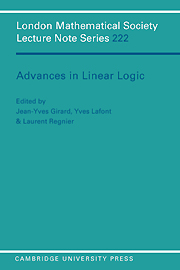Book contents
- Frontmatter
- Contents
- Preface
- Linear Logic: its syntax and semantics
- Part I Categories and semantics
- Part II Complexity and expressivity
- Deciding provability of linear logic formulas
- The direct simulation of Minsky machines in linear logic
- Stochastic interaction and linear logic
- Inheritance with exceptions
- Part III Proof theory
- Part IV Proof nets
- Part V Geometry of interaction
Inheritance with exceptions
Published online by Cambridge University Press: 17 February 2010
- Frontmatter
- Contents
- Preface
- Linear Logic: its syntax and semantics
- Part I Categories and semantics
- Part II Complexity and expressivity
- Deciding provability of linear logic formulas
- The direct simulation of Minsky machines in linear logic
- Stochastic interaction and linear logic
- Inheritance with exceptions
- Part III Proof theory
- Part IV Proof nets
- Part V Geometry of interaction
Summary
Abstract
The problems of inheritance reasoning in taxonomical networks are crucial in object-oriented languages and in artificial intelligence. A taxonomical network is a graph that enables knowledge to be represented. This paper focuses on the means linear logic offers to represent these networks and is a follow-up to the note on exceptions by Girard [Gir92a]. It is first proved that all compatible nodes of a taxonomical network can be deduced in the taxonomical linear theory associated to the network. Moreover, this theory can be integrated in the Unified Logic LU [Gir92b] and so taxonomical and classical reasoning can be combined.
Introduction
The problems of inheritance reasoning in taxonomical networks are crucial in object-oriented languages and in artificial intelligence. A taxonomical network is a graph that enables knowledge to be represented. The nodes represent concepts or properties of a set of individuals whereas the edges represent relations between concepts. The network can be viewed as a hierarchy of concepts according to levels of generality. A more specific concept is said to inherit informations from its subsumers. There are two kinds of edges: default and exception. A default edge between A and B means that A is generally a B or A has generally the property B. An exception edge between A and B means that there is an exception between A and B, namely A is not a B or A has not the property B. Nonmonotonic systems were developed in the last decade in order to attempt to represent defaults and exceptions in a logical way: the set of inferred grounded facts is the set of properties inherited by concepts.
- Type
- Chapter
- Information
- Advances in Linear Logic , pp. 167 - 196Publisher: Cambridge University PressPrint publication year: 1995



